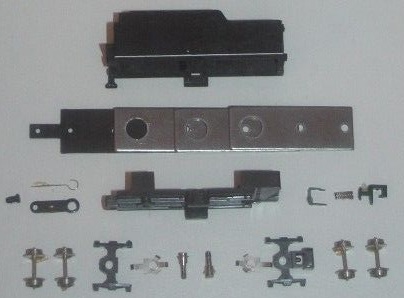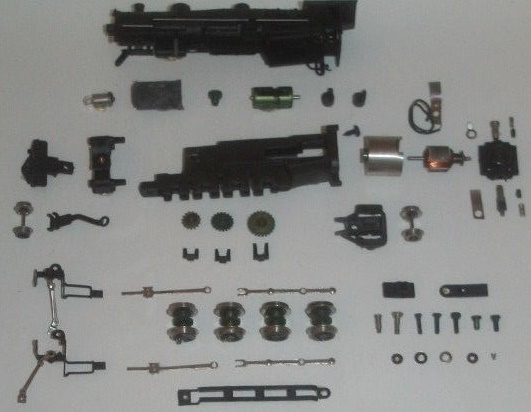



Introduced: 1969 (light 2-8-2) and 1982 (heavy 2-8-2)
Design-wise, these models have much in common with Rivarossi's 4-6-2 Pacific and 0-8-0 Yard Goat models (not to mention a similar evolution and history). Atlas was the original importer for all of the Rivarossi steamers, and continued to offer them up until 1977 (at which point they severed their relationship with Rivarossi). After that, Con-Cor took over as the primary importer and offered the trio (with minor modifications) for many years. Due to the bankruptcy and subsequent liquidation of the Rivarossi Company in February of 2006, these models have been discontinued.
All of the Atlas versions (identified by their clear plastic boxes with blue plastic inserts) have somewhat iffy frames (constructed out of something called "Zamac"), which has a reputation for being quite brittle (especially where the motor screws to the chassis), as well as being prone to heat-related warping and out and out crumbling. No, they don't all have these problems, but enough of them do to merit the reputation (I've certainly run into plenty of warped/cracked frames on these myself over the years).
The Atlas versions also have a very poor quality can motor which was prone to melting down (depending on the year it was made, the motor housing might be black or silver, but regardless of the color the quality is suspect). Right-rail current comes from the right-side tender wheels (via axle wipers), and left-rail current comes from the pilot truck and left-side drivers on the locomotive. All of the rest of the wheels are electrically neutral. Unfortunately, tender current is routed to the locomotive by way of a notoriously unreliable stiff metal wire on the tender drawbar -

All four driver axles are geared and all of the gearing is metal. Two of the right-side drivers are equipped with traction tires. A non-directional headlight is mounted to the front of the chassis. The pilot coupler is a dummy (fixed/non-opertational) knuckle. The tender coupler is a truck-mounted Rapido. The wheel flanges are oversized, so these models will not operate on Code-55 rails.
Unlike Rivarossi's earlier 0-8-0 model, the 2-8-2 uses plastic fork couplings to connect its motorshaft to its worm (as opposed to the Goat, where the worm was an integral part of the motorshaft). Said U-joints allow the motor armature a bit of lateral movement (and with the end result being smoother performance). Consequently, these Mikados run a bit slower and smoother than that earlier model.

As noted above, Con-Cor became the new importer for all of the original Atlas/Rivarossi steamers (2-8-2, 0-8-0, 4-6-2 and 0-4-0) starting in 1977. These early Con-Cor imports made use of the same boxes (clear plastic with a blue plastic insert) that Atlas used - the only difference being a paper sticker slapped on one end identifying Con-Cor as the re-seller. The models themselves remained unchanged for at least several years after the switch.
Starting in the 1980s, Con-Cor began packaging these models in large cardboard boxes with foam inserts. Circa 1989 these were advertised as having "new" motors (although they were still can jobs, so one wonders just how different they really were). Along with the motors, the composition of the chassis metal was also upgraded/improved around this time. The old brittle/crumbly/warpy stuff was replaced with a more reliable mixture - appearing a bit shinier than the old brew.
Circa 1982, a new "Heavy Mikado" version was released. In addition to the original USRA-style tender, a new six-axle Vanderbilt oil tender was also an option. Again, same basic locomotive chassis/mech -

Circa the mid-1990's, Rivarossi started installing open-sided / three-pole / skew-wound Mabuchi motors in these models. Additionally, the wheels were blackened and the the worm carrier and bearings were changed. The old scheme with the brass housing held in the frame by a big brass screw through the top is gone. Instead, there are channels in the frame that are fitted with two plastic "diesel" style bearings (with the worm between them). The two-piece plastic fork between motor and worm is gone. Instead, the worm is linked to the motor by way of a short piece of stiff/clear rubber tubing. By removing two screws from the left side of the frame, the worm can be directly accessed for cleaning and lubrication (a big improvement over the old design).
With the rattling plastic forks gone, these do run quite a bit quieter. However, the rubber tubing makes for a very rigid connection between the motor armature and the worm, and with the end result being excessive load and current draw on the motor. A suggested modification is to remove a thrust washer from either end of the worm and replace them with much thinner ones (to allow some lateral play). Next, replace the rubber tube with a NWSL cup/dogbone universal. Thusly modified, the engine will run much smoother and will draw much less current (good for motor life).
The blackened running gear is easy enough to spot. As for the motor, just unscrew the shell, pull it off and take a look. If you can see the poles through the sides of the motor, you have one of the last (and best) versions. The very last run (sold during Con-Cor's "The Boss Is Retiring" sale) replaced the stiff metal tender contact wire with an insulated mini-wire (running from the tender directly to the motor).
Setting aside the early melty-motor/warpy-frame problems, this is not a bad performing locomotive at all. And the newer the version, the better the performance is going to be. The old Atlas imports can be a bit balky when it comes to pickup, whereas the newer Con-Cor releases with the better motors tend to be much smoother. Yes, the starting speed on all of them is a tad high, and the top-end speed is ridiculously high, but that's understandable given the age of the design. Overall, these were (and remain) very respectable models, both in terms of looks and performance (age being the major determining factor as far as performance is concerned).
Trivia - sometime in the mid-to-late 80's, a large cache of these locomotives (along with Rivarossi Yard Goats and Pacifics) was discovered in the Atlas warehouse in New Jersey. Presumed to be non-running, they were all sold with disclaimer stickers (pictured below) attached to the boxes -

From what I'm told, most (if not all) of them were purchased by Bob's Train Repair in PA. I guess the idea there was to tune them up and sell them and get rich. However, most of them wound up simply getting dumped on eBay during the early 2000's (with lots of ten or more locomotives going for practically nothing).
Grade: B (all versions)
Reviewed: 2/70 Model Railroader ("The ready-to-run model is well proportioned. A few dimensions have been changed for mechanical reasons. As is common in model manufacturing, the engine is about 2 scale feet too long. This is hardly noticeable. The engine and tender bodies are highly detailed plastic castings with all fittings and piping cast on. The engine frame consists of zinc alloy die castings with the motor and drive rigidly secured to them. A small, totally enclosed 12-volt DC motor is used. An excellent worm-and-gear/spur-drive of a design used extensively in N scale is used. This arrangement has all drivers geared, reducing the chance of side-rod bind. All drivers have plastic centers with metal rims. Those used for electrical pickup have a metal disk on the inside which reaches from the rim to the axle. All other wheel pairs have plastic-center wheels on one side. The wheel flanges are .038" deep. The wheel diameters are undersize, perhaps to compensate for the proportionally large flanges: a common practice. The check gauge is .305"... Our sample ran well in all speed ranges. The scale speed at 12 volts is nearly twice that which the prototype could muster... Starting begins with a jerk to an appreciable speed... Our sample began to smoke when run at full voltage with pulse power... Our sample handled 25 freight cars... This is a fine model, and a long-needed piece of motive power. The 2-8-2 is priced $27.98")
Reviewed: 3/85 Model Railroader ("The Con-Cor model, made by Rivarossi, is loosely based on the rebuilt Great Northern Class O-3 locomotives... The model boiler and tender shells, and several other parts are well-detailed plastic castings. The rods, valve gear, tender wheels, and engine wheel tires are metal. The engine frame is composed of zinc-alloy castings held together with machine screws. A can-type motor is mounted in the cab. The mechanism is a combination of a worm-and-gear set with spur gears to all four driver sets. The second and fourth driver on the right side have friction treads. The drivers are a scale 60" in diameter (63" was the correct size), but with the usual deep (.032") flanges used on N scale equipment, the overall driver size remains in correct proportion to the whole engine. Since all of the drivers are geared, quartering is not critical. The main rods are secured to the main drivers and the rod front ends are slotted to fit over the front crank pins. The second and fourth driver crank-pin connections are only simulated as they are not actually connected to the rods. The valve gear is also a simulation of the prototype's Walschaerts gear, and it tends to be a bit bulky. I found the check gauge on all wheelsets to be under the NMRA standard... While the model will go around very sharp-radius curves, it looks best on the larger-radius curves... There is a scale dummy coupler on the pilot, and a Rapido-type coupler on the tender... This is a really nice-running model. I took it out of the box, placed it on the track, and it ran very well and at reasonable speeds... The model ran close to 6 scale MPH at 5.2 volts... The model will pull about 20 freight cars... This is a neat model in spite of the variances from true Great Northern practice. It runs well and has good detail. Undec, GN, SP, UP, PRR. $94.98")